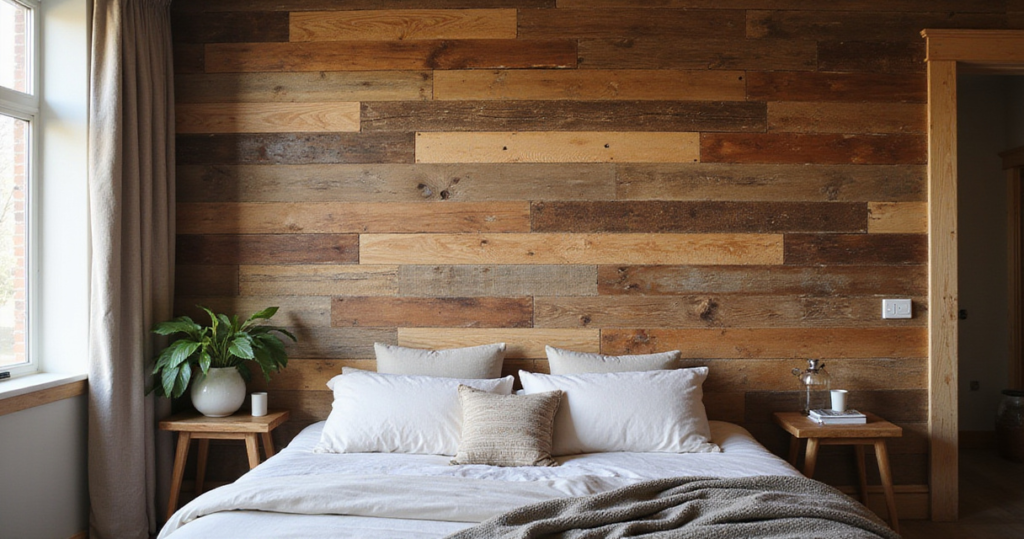Picture stepping into a bedroom where weathered wood whispers tales of bygone eras, where every texture invites you to linger a little longer, and where the very air seems to exhale warmth and tranquillity. This isn’t merely about creating a place to sleep—it’s about crafting a personal sanctuary that honours the imperfect beauty of natural materials and the comforting embrace of lived-in spaces.
The rustic aesthetic celebrates authenticity over perfection, choosing the honest grain of reclaimed timber over pristine surfaces, and the gentle patina of age over factory-fresh finishes. It’s a design philosophy that draws inspiration from English country cottages, Highland hunting lodges, and the timeless appeal of spaces that have gracefully weathered the passage of time. In our increasingly digital world, these spaces offer something invaluable: a tangible connection to craftsmanship, heritage, and the enduring appeal of natural materials.
Creating your own rustic bedroom retreat doesn’t require a complete overhaul or an unlimited budget. Often, it’s about making thoughtful choices that layer character and warmth throughout the space. From architectural elements that anchor the room’s personality to the smallest decorative touches that tell your story, each decision contributes to an atmosphere of genuine comfort and timeless appeal.
1. Install a Reclaimed Wood Accent Wall
Nothing transforms a bedroom quite like the instant character and warmth that reclaimed wood brings to a feature wall. Each weathered plank carries its own history—perhaps from a Victorian warehouse in Manchester or a centuries-old Yorkshire barn—creating a backdrop that’s impossible to replicate with new materials. The natural variations in colour, the honest nail holes, and the gentle undulations of aged timber create a focal point that immediately establishes your room’s rustic credentials whilst adding considerable visual depth.
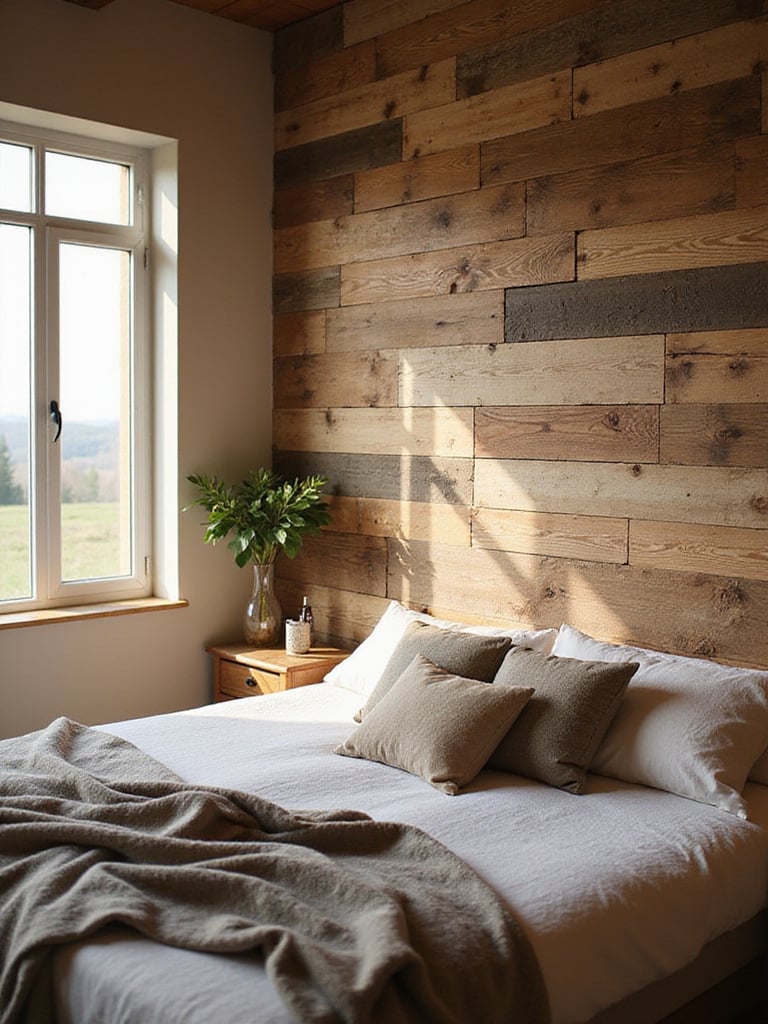
Beyond mere aesthetics, reclaimed wood offers compelling practical benefits. You’re contributing to environmental sustainability by diverting materials from landfills whilst reducing demand for new timber—each ton of reclaimed wood saves approximately 1.2 tons of carbon dioxide compared to new lumber. The thermal properties of aged wood also contribute to a room’s warmth, both literally and figuratively, whilst the natural texture provides excellent acoustic softening. Installation requires careful planning and proper preparation, particularly ensuring the wood is properly dried and treated, but the transformation is immediate and dramatic.
What makes this choice particularly special is how dramatically it changes the room’s entire character…
2. Choose Distressed Wide-Plank Wood Flooring
The foundation of any successful rustic bedroom lies beneath your feet, and distressed wide-plank flooring provides the perfect canvas for building your retreat. These generous planks, typically five inches or wider, feature surfaces deliberately aged to reveal the honest wear patterns of decades past. The wider format creates fewer seam lines across your floor, lending a sense of spaciousness whilst the distressed finish ensures that future scuffs and marks simply add to the character rather than detracting from it.
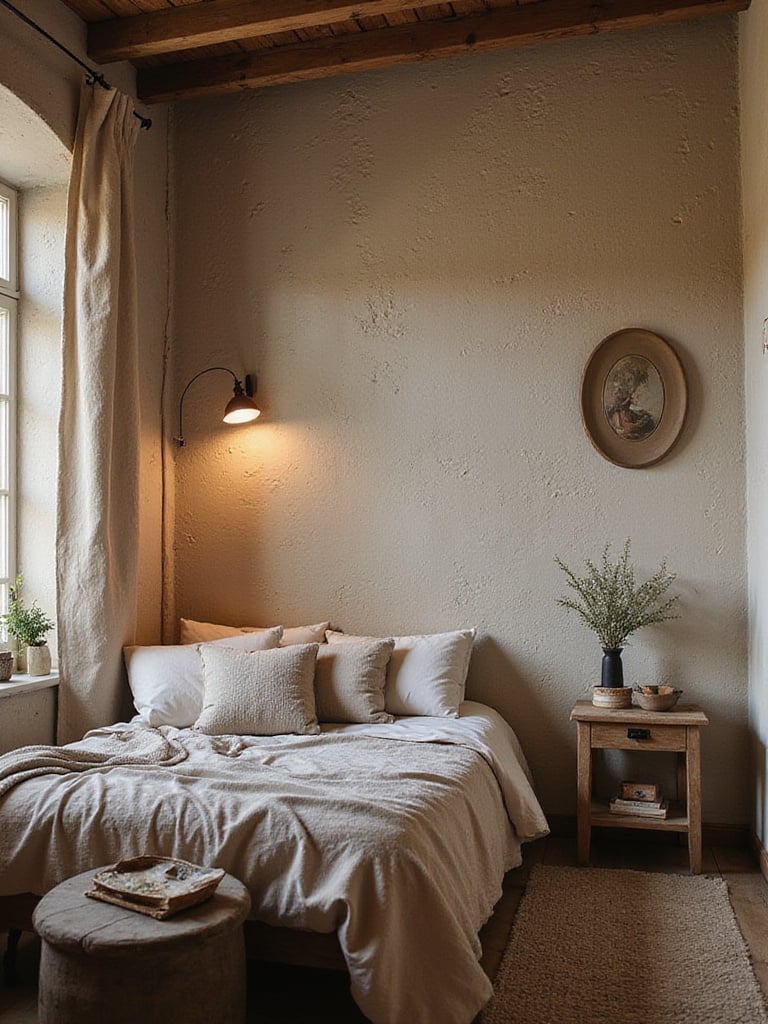
Modern distressed flooring cleverly combines old-world charm with contemporary durability through advanced protective finishes that preserve the aged appearance whilst offering exceptional resistance to daily wear. This means you can enjoy the authentic look of centuries-old floorboards with the practical benefits of modern engineering. The visual weight of these substantial planks helps ground your furniture arrangement, creating a stable foundation that makes everything else in the room feel more intentional and rooted.
The interplay between the colours creates an ideal foundation for layering other rustic elements…
3. Add Faux or Real Wood Beams to the Ceiling
Drawing the eye upward with exposed beams transforms a flat ceiling into an architectural feature that immediately establishes rustic credentials. Whether you choose authentic reclaimed timbers or high-quality faux alternatives made from lightweight polyurethane, beams add visual weight and historical character that makes even new-build bedrooms feel as though they’ve stood for generations. The horizontal lines create a sense of shelter and enclosure that’s particularly welcome in a bedroom, contributing to that essential feeling of sanctuary.

The choice between real and faux beams often comes down to practical considerations rather than aesthetic ones—modern faux beams can be remarkably convincing whilst being significantly lighter and easier to install. They require no structural modifications and can be fitted in a weekend, yet provide the same visual impact as their authentic counterparts. Proper spacing is crucial; beams positioned 4-8 feet apart with proportional thickness create the most pleasing visual rhythm without overwhelming the space.
- Measure your ceiling carefully before selecting beam size
- Consider the room’s scale—larger rooms can accommodate more substantial beams
- Install on a dimmer system for flexible ambient lighting options
Beyond the obvious placement, consider using these structural elements to define different zones within your bedroom…
4. Apply Textured Paint to Mimic Stone Finishes
The walls of traditional rustic interiors often featured lime plaster or natural stone, surfaces that developed character through decades of use. Modern textured paints allow you to capture this authentic aged quality without the expense or structural requirements of genuine materials. Specialised plaster-effect paints create convincing depth and tactile interest, transforming flat surfaces into something that feels genuinely historical and adds substantial visual warmth to your retreat.
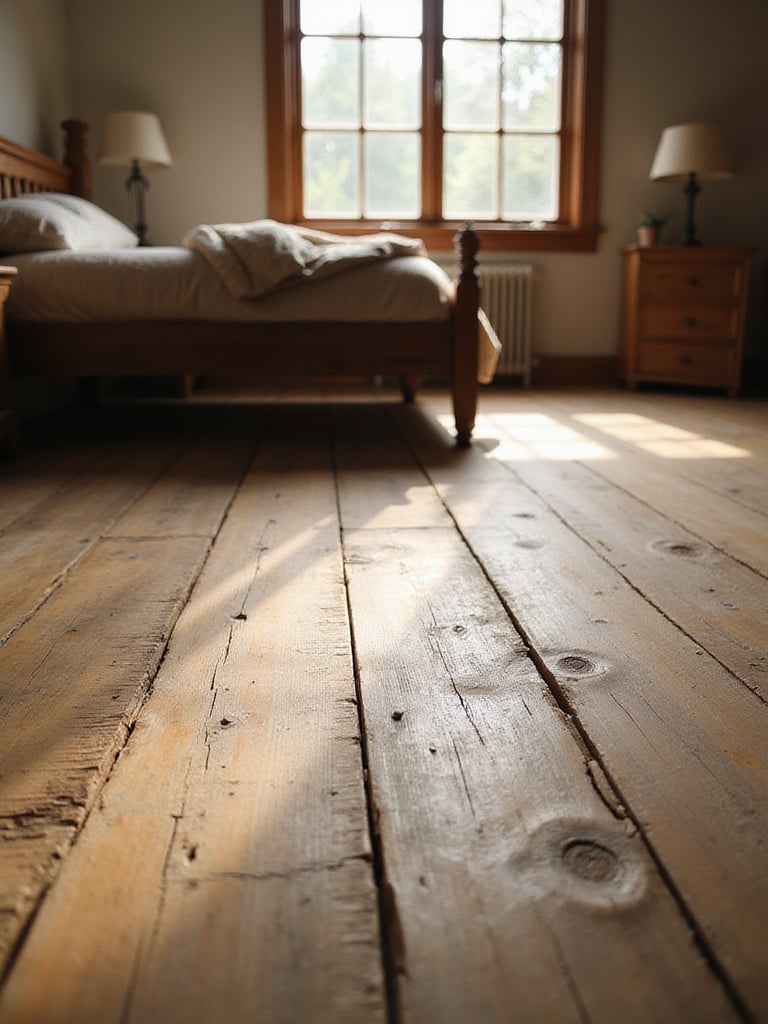
The technique lies in the application—using trowels, brushes, or textured rollers to create organic patterns that mimic the irregular surfaces of hand-applied plaster or natural stone. Working in small sections allows you to maintain control over the texture whilst building up layers that catch and reflect light naturally throughout the day. The key is embracing imperfection; the slight variations and organic patterns are what make the finish feel authentic rather than manufactured.
- Start with a high-quality primer for proper adhesion
- Practice your technique on a test board before tackling the walls
- Work with a partner to maintain wet edges and consistent texture
The visual weight balances perfectly when you pair these textured surfaces with substantial furniture pieces…
5. Select a Sturdy Log or Live-Edge Wood Bed Frame
The bed frame serves as your bedroom’s anchor, and choosing one crafted from natural logs or featuring live-edge slabs immediately establishes your commitment to authentic rustic design. These pieces celebrate the inherent beauty of wood in its most natural state—the organic curves of live edges or the substantial presence of whole logs create furniture that feels more like sculpture than mass production. Each piece is genuinely unique, shaped by the tree’s growth patterns and the craftsman’s interpretation of its natural form.
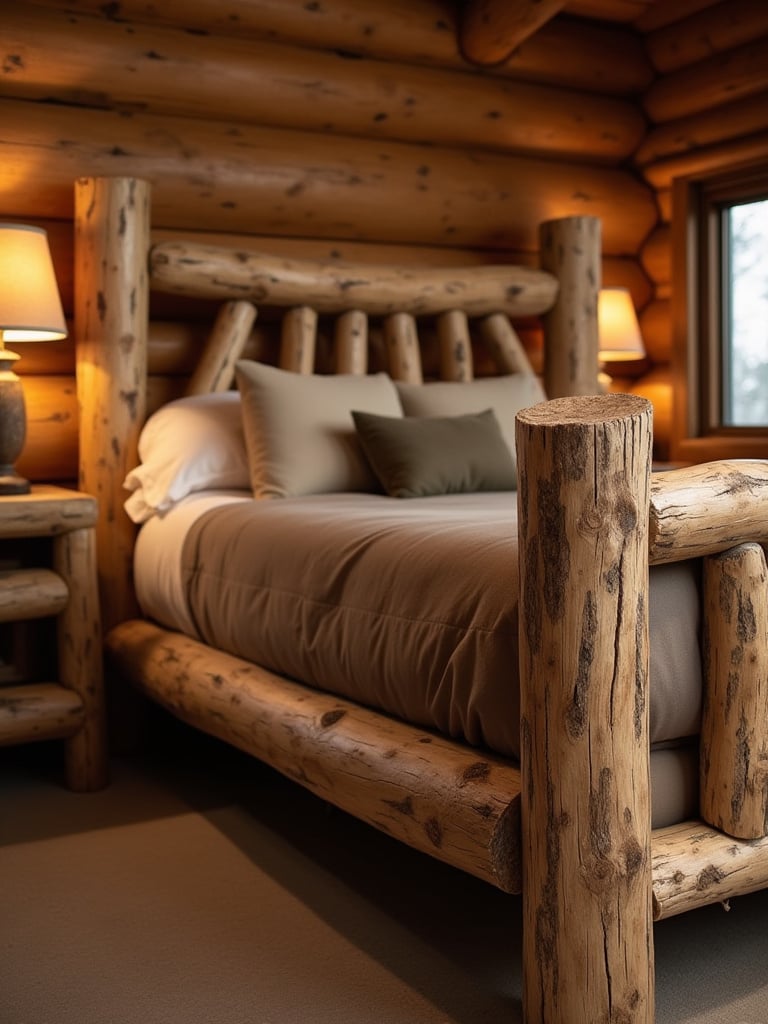
Beyond their undeniable visual impact, these substantial frames offer exceptional longevity and a connection to traditional craftsmanship that’s increasingly rare in modern furniture. The natural variations in grain and colour ensure your bed frame remains visually interesting from every angle, whilst the solid construction provides a sleeping experience that feels grounded and secure. When selecting such pieces, consider the wood’s provenance and treatment—properly kiln-dried timber and quality joinery ensure your investment will serve you for decades.
The artisan collective that creates these pieces often brings generations of woodworking knowledge to each frame…
6. Build a Budget-Friendly Pallet Wood Bed Base
Not every rustic element requires a significant investment, and a thoughtfully constructed pallet wood bed base proves that authentic character can be achieved on virtually any budget. Using reclaimed shipping pallets—properly selected and prepared—creates a platform that embodies the rustic principle of repurposing whilst providing excellent support for your mattress. The key lies in choosing heat-treated pallets (marked ‘HT’) and avoiding those treated with harmful chemicals.

The construction process becomes an opportunity to customise exactly what you need—adjusting height, adding storage underneath, or incorporating subtle lighting elements. Proper preparation is essential: thorough cleaning, careful sanding to eliminate splinters, and application of appropriate sealers protect both your health and your investment. The resulting platform celebrates the honest construction methods and visible joinery that characterise authentic rustic furniture.
- Source only heat-treated (HT) pallets for indoor use
- Sand all surfaces thoroughly to prevent splinters
- Apply food-safe wood finish for bedroom use
- Secure all joints with quality hardware for stability
The unexpected pairing that always works is combining this humble material with luxurious bedding…
7. Incorporate a Distressed or Antique Dresser
A carefully chosen antique or distressed dresser brings instant gravitas and history to your rustic bedroom, serving as both essential storage and a significant design anchor. These pieces carry the patina of decades, with surfaces that tell stories through gentle wear patterns, original hardware, and the subtle colour variations that only time can create. Unlike mass-produced furniture, each antique dresser possesses unique character that makes your bedroom feel curated rather than simply furnished.
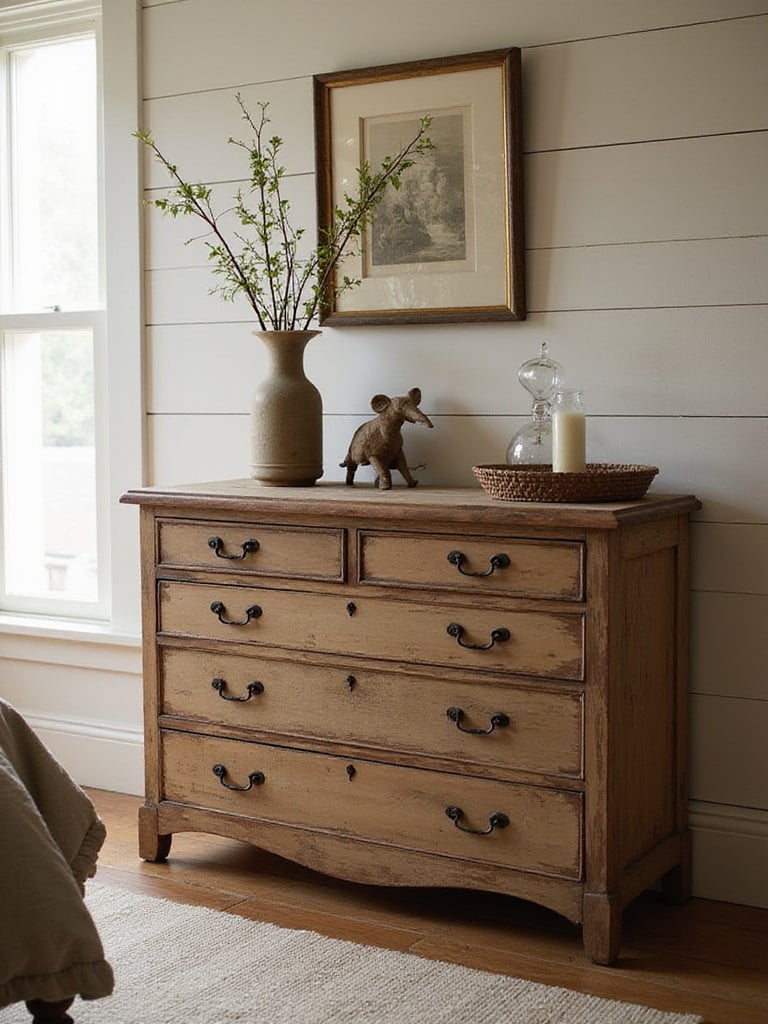
The practical benefits extend beyond aesthetics—quality antique furniture was often constructed using superior joinery techniques and solid wood construction that far exceeds modern equivalents. The investment often proves economical over time, as these pieces appreciate rather than depreciate whilst providing storage solutions that adapt to changing needs. When selecting pieces, focus on structural integrity over surface imperfections; authentic wear adds character, but loose joints or damaged drawers require professional attention.
The craftsmanship reveals itself in details like hand-cut dovetail joints and original brass hardware…
8. Find Unique Rustic Nightstands or Tree Stumps
The surfaces beside your bed offer opportunities to introduce genuinely organic elements that connect your indoor retreat directly to the natural world. Whether you choose handcrafted nightstands from reclaimed materials or embrace the ultimate rustic statement of properly prepared tree stumps, these pieces should feel like natural extensions of the landscape rather than manufactured furniture. Each option brings unique character whilst providing essential bedside functionality.
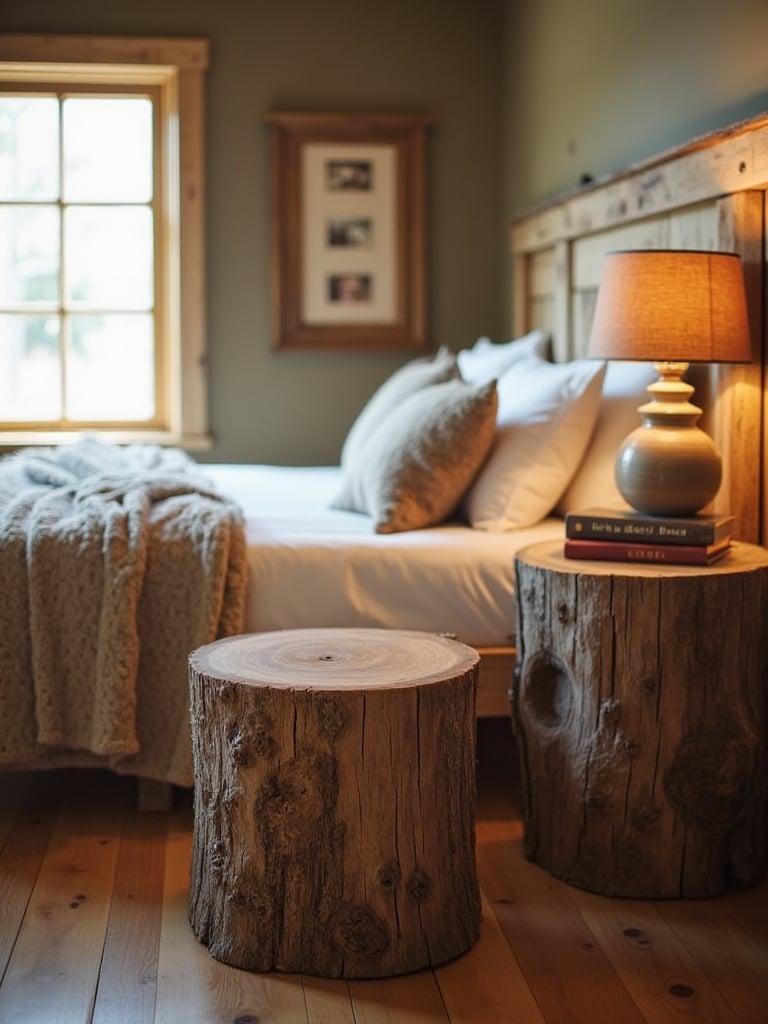
Tree stumps require careful preparation to become suitable furniture—proper drying, pest treatment, and protective finishing transform raw wood into functional surfaces that celebrate natural form. The irregular shapes and visible growth rings create conversation pieces that anchor your bedroom’s connection to nature. For those preferring traditional nightstands, seek pieces that show honest construction, visible wood grain, and perhaps the gentle wear that speaks of previous lives in different settings.
- Ensure stumps are properly kiln-dried before use
- Apply penetrating sealers to prevent cracking
- Add felt pads to protect flooring
- Consider height carefully for bedside functionality
The sustainable journey of this material involves selecting pieces that honour the tree’s natural life cycle…
9. Layer Cozy Flannel, Knits, and Faux Fur Bedding
The textiles on your bed provide the most immediate sensory connection to comfort and warmth, making thoughtful layering essential for creating a true retreat atmosphere. Beginning with quality flannel sheets creates a foundation of softness that improves with washing, developing the lived-in character that defines authentic rustic style. Adding chunky knit throws and luxurious faux fur elements builds visual depth whilst providing adaptable warmth for different seasons and personal preferences.
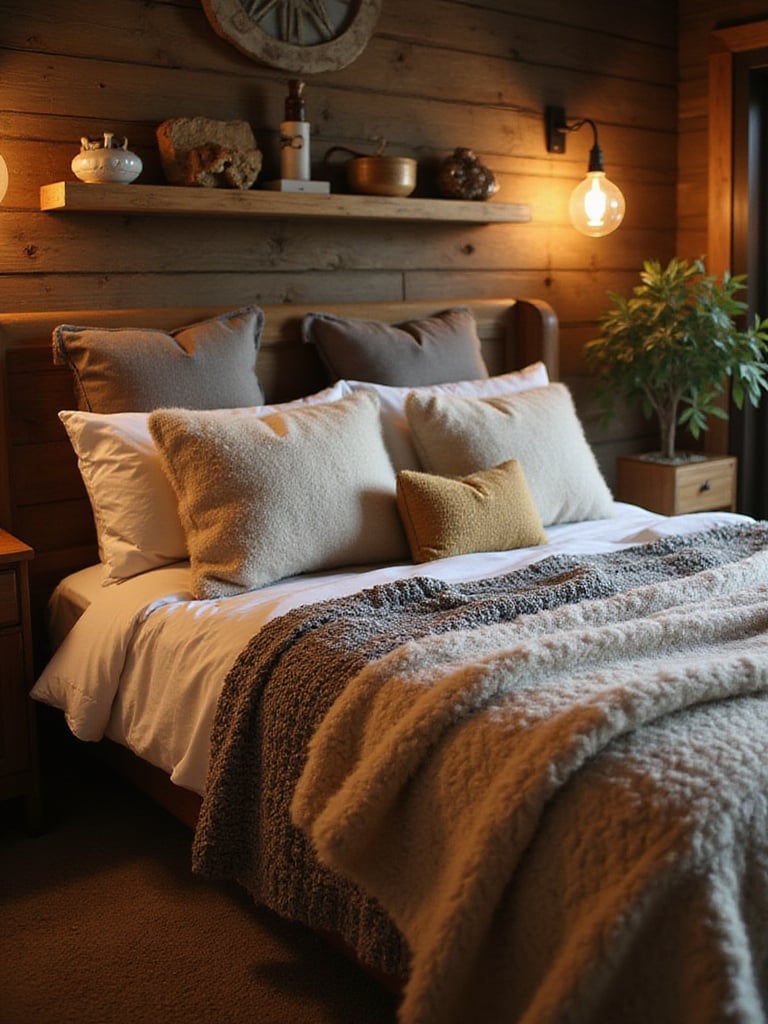
The key to successful layering lies in varying textures rather than competing patterns—a solid flannel base allows the organic irregularities of hand-knit textures and the plush luxury of faux fur to truly shine. This approach creates visual interest without overwhelming the space, whilst the varied tactile experiences invite touch and contribute to the overall sense of comfort. Quality natural fibres not only feel better but also develop character over time, becoming softer and more appealing with use.
- Mix textures rather than patterns for sophisticated layering
- Choose natural fibres that improve with age
- Vary the scale of knits for visual interest
- Consider seasonal adaptability when selecting pieces
The emotional response this evokes begins with the first touch of natural fibres against skin…
10. Anchor the Room with a Natural Fiber Area Rug
A substantial natural fibre rug serves as the foundation that visually unifies your bedroom’s furniture arrangement whilst adding essential warmth and texture underfoot. Materials like jute, sisal, or seagrass bring the organic irregularities and honest textures that complement rustic design whilst providing practical benefits like durability and natural stain resistance. The neutral tones of these fibres create a perfect backdrop that allows other elements—wood furniture, metal accents, and colourful textiles—to shine.
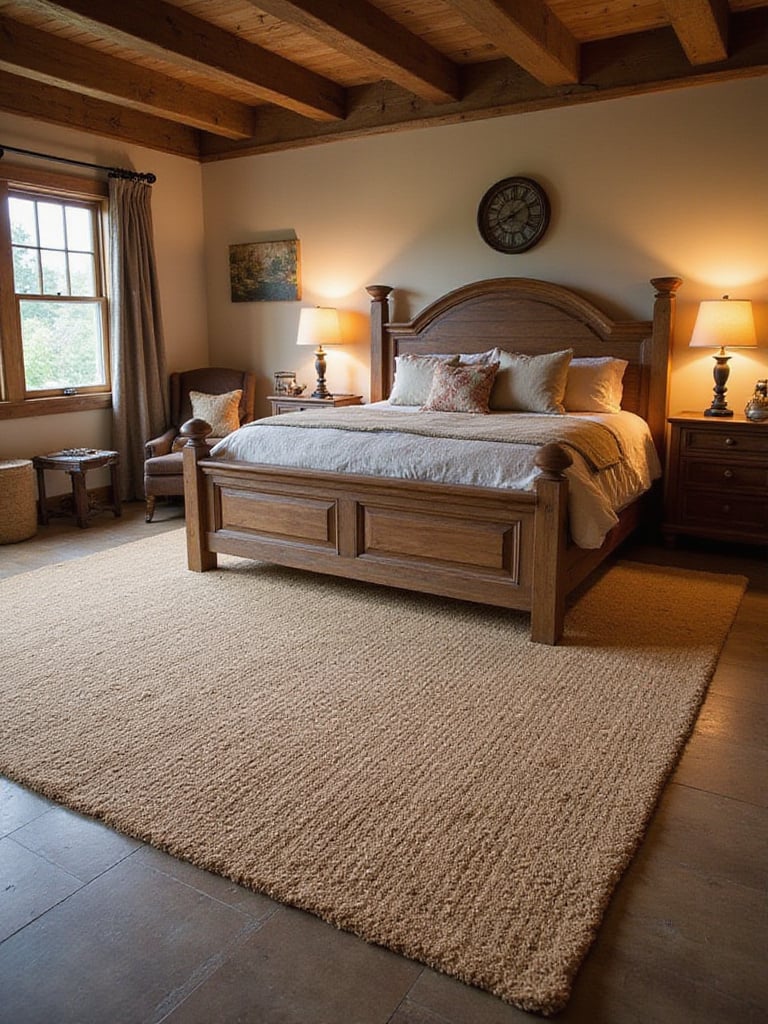
Proper sizing makes the difference between a rug that grounds the space and one that appears lost—your rug should extend well beyond the bed’s footprint, allowing at least the front legs of nightstands to rest upon it. This creates a defined zone within the larger room whilst the natural texture variations inherent in these fibres add visual interest that changes throughout the day as light shifts across their surface.
The tactile experience changes the entire room’s energy when you step from hard flooring onto natural fibres…
11. Opt for Warm, Ambient Lighting Fixtures
Lighting shapes the mood of any space more powerfully than perhaps any other single element, and in a rustic bedroom, warm, diffused illumination creates the essential atmosphere of comfort and retreat. Choosing fixtures that emit light in the 2200K to 2700K range mimics the golden warmth of firelight or candlelight, immediately making spaces feel more intimate and welcoming. This approach requires layering multiple light sources at different heights rather than relying on harsh overhead illumination.
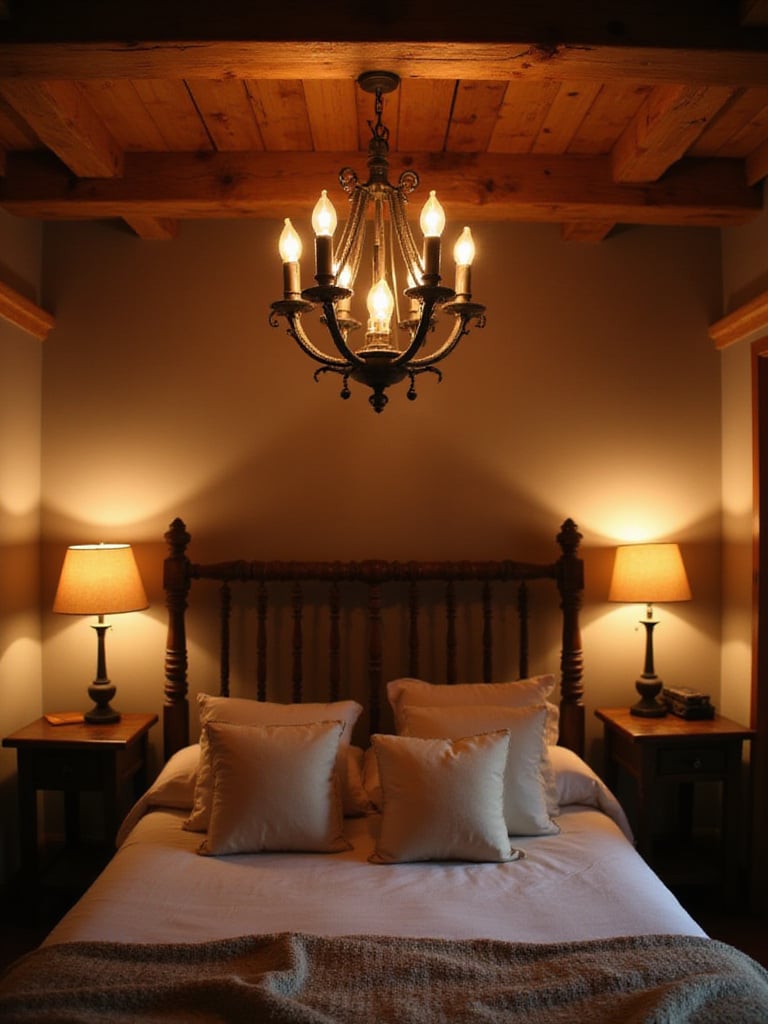
The fixtures themselves become opportunities to reinforce your rustic theme—wrought iron table lamps, reclaimed wood pendant lights, or vintage-inspired sconces add character whilst providing functional illumination. Installing dimmer controls on all circuits allows you to adjust brightness throughout the day, creating bright, energising light for morning routines and soft, relaxing ambiance for evening wind-down. The interplay of warm light with natural wood textures creates depth and richness that harsh lighting simply cannot achieve.
- Layer multiple light sources for flexibility
- Choose bulbs with warm colour temperatures (2200K-2700K)
- Install dimmers for mood control
- Consider how light interacts with wood grain and textures
The ambiance evolves throughout the day as natural light gives way to the warm glow of carefully chosen fixtures…
12. Hang an Antler Chandelier for a Statement Piece
For those seeking to make a bold declaration of rustic style, an antler chandelier provides immediate visual impact whilst serving as the room’s defining focal point. Whether crafted from naturally shed antlers or high-quality reproductions, these fixtures capture the essence of lodge-style luxury whilst providing essential ambient lighting. The organic forms and natural variations ensure each piece possesses unique character that manufactured fixtures simply cannot replicate.

Modern antler chandeliers often incorporate LED technology and dimming capabilities, combining traditional aesthetics with contemporary functionality. The choice between authentic shed antlers and carefully crafted alternatives often comes down to weight considerations and ethical preferences—both can create stunning focal points when properly scaled to the room. Installation requires careful attention to structural support, as these substantial fixtures demand secure mounting to ceiling joists or appropriate blocking.
The designer’s secret here is to balance the chandelier’s visual weight with other substantial elements in the room…
13. Create DIY Mason Jar Pendant Lights
Handcrafted elements add personal character that purchased fixtures cannot match, and mason jar pendant lights represent the perfect intersection of rustic charm and practical illumination. These simple projects transform humble glass jars into charming light fixtures that provide focused task lighting or gentle ambient glow, depending on your bulb choice and placement. The appeal lies not just in cost savings but in the satisfaction of creating something uniquely yours.

Safety must guide every aspect of this project—using only UL-listed electrical components and LED bulbs prevents overheating whilst ensuring reliable operation. The beauty of mason jars lies in their inherent imperfections and slight variations, qualities that enhance rather than detract from their rustic appeal. Consider frosting the interior with specialised glass spray for softer light diffusion, or leave them clear to showcase vintage-style filament bulbs.
- Use only UL-listed electrical components for safety
- Choose LED bulbs to prevent overheating
- Consider frosted glass treatment for softer light
- Install dimmer switches for mood control
What makes this choice better for our planet is the repurposing of common materials into functional art…
14. Bring Nature Indoors with Branches and Pinecones
The simplest rustic elements often prove the most effective, and incorporating natural materials like carefully selected branches and pinecones creates immediate connections to the outdoor world. These elements cost virtually nothing yet provide authentic texture and organic forms that manufactured decorations cannot replicate. The key lies in proper selection and preparation—choosing materials with interesting shapes and ensuring they’re properly cleaned and treated to prevent pest issues.
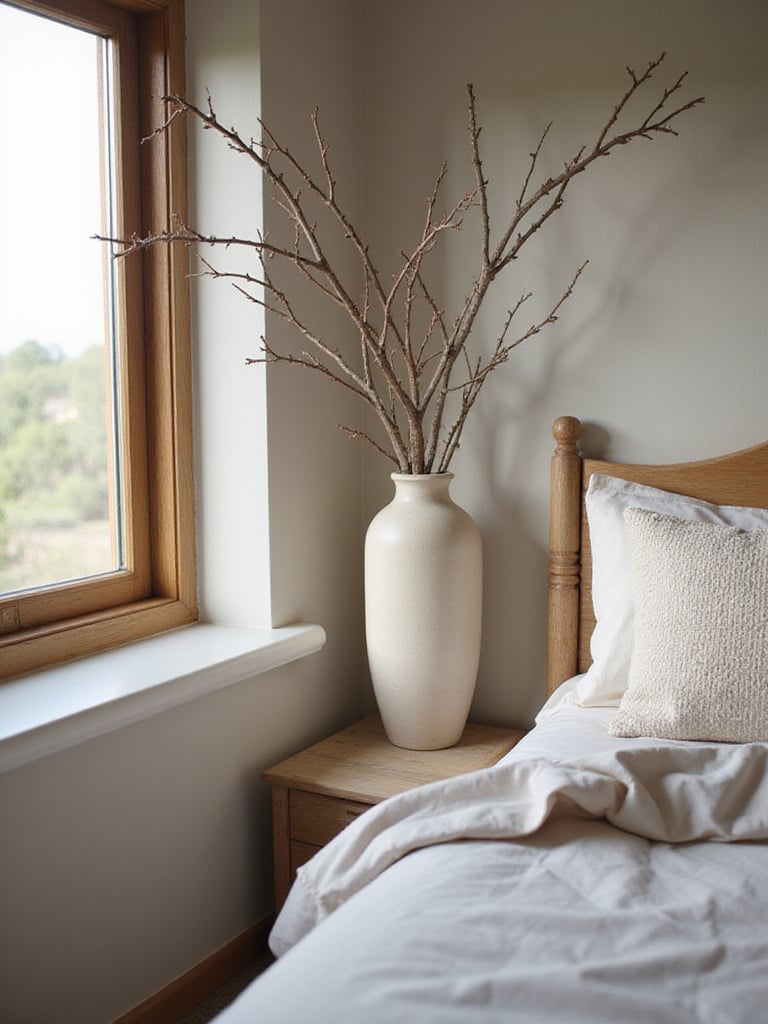
Large sculptural branches can fill empty corners or frame windows, whilst collections of pinecones in wooden bowls add textural interest to surfaces. The seasonal availability of these materials allows you to refresh your displays regularly, keeping your rustic elements feeling fresh and connected to the natural cycles outside your windows. Proper preparation—cleaning, baking to eliminate pests, and light sealing—ensures these natural elements remain beautiful rather than problematic.
The cultural heritage preserved in each piece includes traditional methods of bringing the outdoors inside…
15. Decorate with Vintage Finds and Antiques
Authentic rustic style emerges from layering pieces with genuine history and character, making vintage finds and antiques essential elements rather than optional additions. These pre-loved treasures bring the patina of age and the stories of previous owners, creating depth and authenticity that new items simply cannot provide. The hunt for perfect pieces becomes part of the pleasure, as each discovery adds another layer to your room’s unique narrative.
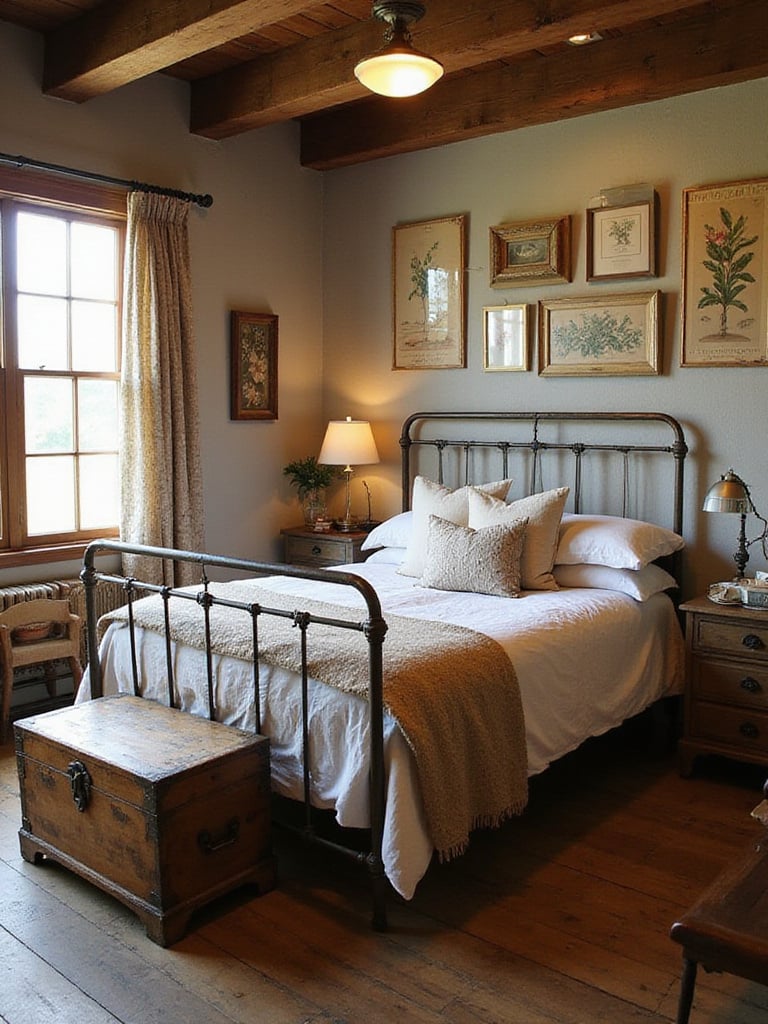
The environmental benefits of choosing vintage items extend your rustic philosophy beyond aesthetics—repurposing existing pieces reduces demand for new manufacturing whilst diverting quality items from landfills. Often, vintage pieces were constructed with superior materials and techniques, making them not just characterful but genuinely more durable than modern equivalents. The key lies in developing an eye for potential rather than perfection, seeing how pieces might be cleaned, lightly restored, or repurposed to serve new functions.
- Visit markets and shops regularly as inventory changes constantly
- Look beyond current condition to see potential
- Inspect structural integrity before purchasing
- Consider how pieces might be repurposed or updated
The unexpected material discovery story often emerges when you least expect to find treasure…
16. Curate a Gallery Wall Using Rustic Frames
A thoughtfully assembled gallery wall transforms blank wall space into a personal narrative whilst reinforcing your rustic aesthetic through carefully chosen frames. The power lies not just in the images displayed but in the frames themselves—reclaimed wood, distressed finishes, and varied sizes create visual interest that celebrates imperfection over uniformity. This approach allows you to display cherished memories and meaningful art whilst contributing to the room’s overall character.
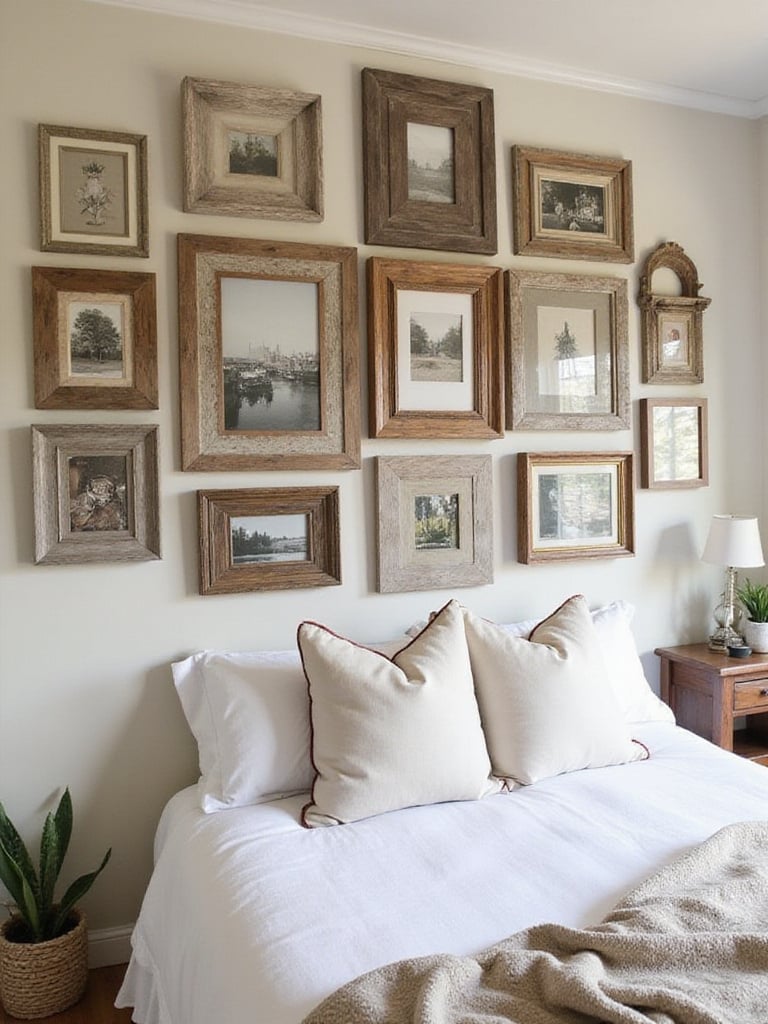
The curation process becomes an opportunity to tell your story through both content and presentation. Mixing frame styles, sizes, and even orientations prevents the display from feeling too studied whilst the consistent rustic materials ensure visual cohesion. The arrangement itself should feel organic rather than rigidly geometric, perhaps echoing the irregular patterns found in nature or traditional cottage arrangements where practicality trumped perfect symmetry.
The composition comes together when you embrace the irregular spacing and varied scales that characterise authentic rustic displays…
17. Add a Distressed Wood or Metal Frame Mirror
Mirrors serve essential practical functions whilst offering opportunities to enhance your rustic theme through carefully chosen frames that show honest wear and authentic aging. A substantial mirror with a distressed wood or weathered metal frame becomes both functional necessity and decorative focal point, reflecting light to brighten the space whilst adding textural interest through its aged surface. The patina of time visible in these frames reinforces the rustic preference for materials that improve with age.
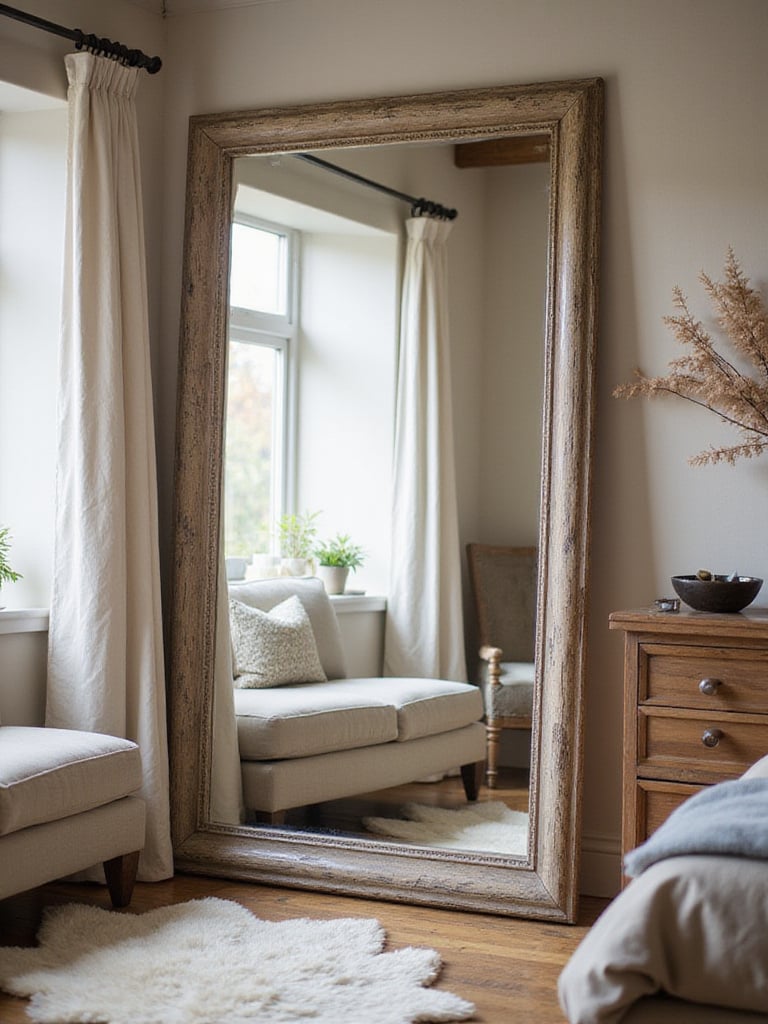
Strategic placement maximises both functional and aesthetic benefits—positioning mirrors to reflect natural light sources brightens the entire room whilst careful consideration of what the mirror reflects can effectively double pleasing views or interesting architectural details. The frame itself should show genuine character rather than manufactured distressing, with wear patterns that feel authentic rather than artificially applied.
The styling mistake most people make is choosing mirrors too small for their intended impact…
18. Craft a Unique Reclaimed Wood Headboard
Creating a headboard from reclaimed materials allows you to craft a truly unique focal point whilst embodying the rustic principles of repurposing and celebrating natural materials. Each piece of salvaged wood carries its own history—perhaps from Victorian railway sleepers or Georgian farmhouse timbers—creating a backdrop that’s impossible to replicate with new materials. The project becomes an opportunity to create something perfectly scaled to your space whilst developing hands-on connection to traditional craftsmanship.

The construction process requires careful planning but rewards patience with a piece that perfectly reflects your personal style. Proper preparation of reclaimed materials—cleaning, treating for pests, and carefully sanding whilst preserving character—ensures your headboard remains beautiful and problem-free. The natural variations in colour and texture that make reclaimed wood so appealing also ensure your finished piece possesses unique character that manufactured alternatives cannot match.
The traditional methods used result in headboards that become more beautiful with age rather than showing wear…
19. Install Floating Shelves from Live-Edge Wood
Live-edge floating shelves celebrate the natural form of wood whilst providing practical display space that feels organic rather than manufactured. These shelves preserve the tree’s original outer edge, creating organic lines that soften the geometric precision of modern rooms whilst providing surfaces for displaying treasured objects or essential items. The hidden mounting system creates the illusion that these natural elements are growing directly from your walls.

Proper installation requires attention to both aesthetics and structural requirements—live-edge wood can be substantially heavier than standard shelving, demanding secure mounting into wall studs rather than relying on hollow wall fixings. The natural variations in edge shape mean each shelf is genuinely unique, requiring individual consideration for both mounting and styling. The organic forms work particularly well for displaying other natural elements or simple, unadorned objects that don’t compete with the wood’s inherent beauty.
The forest where this walnut grew stands just ninety miles from the workshop where it was transformed…
20. Source Affordable Decor from Thrift Stores
The most authentic rustic elements often come from unexpected sources, making regular exploration of charity shops, car boot sales, and antique markets essential for developing your bedroom’s character. These venues offer opportunities to discover genuine vintage pieces with authentic patina and wear patterns that manufactured items cannot replicate. The hunt becomes part of the pleasure, as each expedition might yield the perfect lamp, mirror, or decorative object that completes your vision.

Successful thrifting requires developing an eye for potential rather than perfection—seeing how a tarnished brass candlestick might be gently restored or how a worn wooden box could serve new purposes. The key lies in focusing on quality construction and interesting materials rather than current condition, as many issues can be addressed with careful cleaning and minor restoration. This approach not only saves money but ensures your rustic bedroom contains pieces with genuine history and character.
The discovery of this technique happened when designers realised that authentic character cannot be manufactured…
21. Update Hardware with Industrial or Blacksmith Pulls
The smallest details often make the greatest impact, and replacing standard cabinet hardware with pieces showing blacksmith craftsmanship or industrial heritage instantly elevates existing furniture. Hand-forged iron pulls, aged brass handles, or industrial-inspired hardware transform ordinary dressers and wardrobes into pieces that feel authentically rustic. The visible signs of hand-crafting—slight irregularities, tool marks, and natural patina—add character that mass-produced hardware cannot provide.
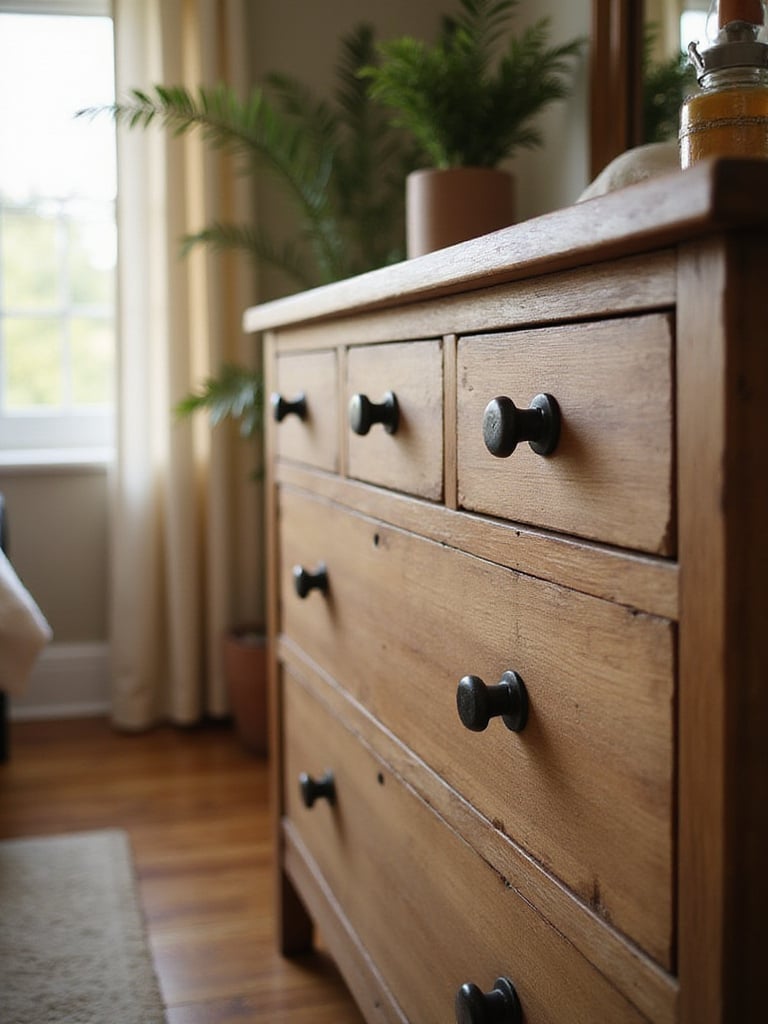
The transformation extends beyond individual pieces to influence the room’s entire character, as these substantial hardware pieces add visual weight and tactile interest that reinforces your rustic theme. Quality hardware often outlasts the furniture it adorns, making this upgrade both practical and aesthetic. The key lies in choosing pieces that feel substantial and show genuine craftsmanship rather than manufactured distressing or artificial aging.
Conclusion
Creating a rustic bedroom retreat requires more than simply adding a few weathered accessories—it demands a thoughtful approach that celebrates natural materials, embraces imperfection, and honours the beauty of things that improve with age. These 21 rustic bedroom ideas provide a comprehensive foundation for transforming your space into a genuine sanctuary that reflects both comfort and character. From substantial architectural elements like reclaimed wood walls to intimate details like hand-forged hardware, each choice contributes to an atmosphere that feels both timeless and deeply personal.
The beauty of rustic design lies in its accessibility and sustainability. Many of these ideas celebrate repurposing and natural materials, allowing you to create something meaningful whilst treading lightly on the environment. Whether you tackle ambitious projects like crafting a reclaimed wood headboard or simply begin by layering cozy textiles and incorporating vintage finds, each step moves you closer to a bedroom that truly serves as a retreat from the modern world.
The journey toward your perfect rustic bedroom needn’t happen overnight. Choose elements that resonate most strongly with your vision and begin there—perhaps sourcing a beautiful antique dresser or creating that accent wall you’ve been contemplating. Remember that authentic rustic style develops over time, growing richer and more personal as you discover pieces that speak to you and add layers that tell your unique story.
